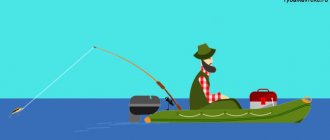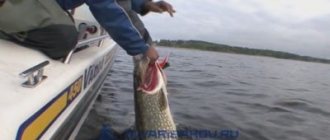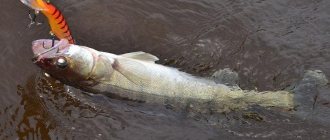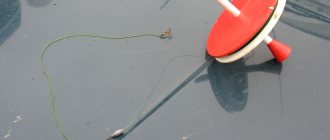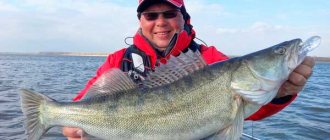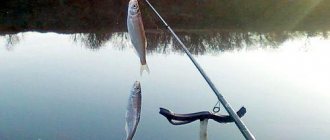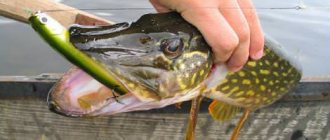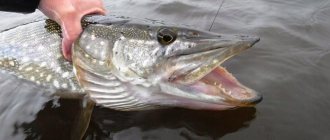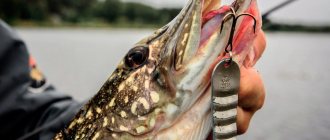What gear do you need to have to fish like this? You don't have to buy anything fancy. If you have caught large fish by trolling before, then you certainly won’t need to radically change your equipment, and it is possible that in general everything you need will be found in the equipment you already have. Due to the fact that fishing is carried out at high speeds, tackle and rod holders experience increased loads - this is what you should pay close attention to when selecting equipment. Rod holders must be durable. A proven and reliable solution is the Scotty holder - made of composites, it reliably fixes the rod during retrieving and withstands the bite of any fish in our latitudes. As for the fishing rods, there is no need to stand on ceremony with them. The fishing under discussion does not require expensive high-tech spinning rods made of high-modulus graphite - just the opposite - pure graphite rods are of little use, as they are too fragile. The best solution would be to purchase a Penn composite rod that combines carbon and glass fibers.
There shouldn't be a light class for a rod. You will also need a universal reel, suitable for trolling and capable of holding a sufficient amount of fishing line on the spool, or better yet, braided cord. In the vast majority of cases, 150 yards of cord is enough for the eyes and ears. What you should pay attention to when choosing a reel is its brakes - they must be reliable. Remember that when biting, it is the reel brake that will bear the maximum load. Personally, I prefer Daiwa reels. For line, I prefer 27-pound breaking braided line, which is the best choice for light trolling. If you are using large baits and hoping to catch a really decent fish, I advise you not to waste time on trifles and fish with stronger lines with a breaking load of 36-45 pounds. As for baits suitable for high-speed trolling, their range is quite wide. You can find the necessary baits in the assortment of Depth Raiders, Believers, Swim Whizz or Grandma Baits, as well as other manufacturers of artificial baits for trolling fishing.
Source: fisherman2000.mirtesen.ru
Boat speed when trolling for pike
Trollers have a saying: “The slower you go, the more you catch.” It means that the lower the speed of the boat under trolling, the more predator bites. In general terms this saying is true. If you go at a speed of 5 km/h, you get, for example, 3 bites for every kilometer of trolling. Reduce your speed to 3 km/h and you will be surprised at the results.
However, one should not forget about such characteristics as the speed of the river flow or deep currents in the bays of large reservoirs. And yet, the speed of the boat when trolling is also an “experimental” factor. The more you experiment and think, the better your results from fishing to fishing.
Wobbler design for pike trolling
And finally, there are wobblers that are structurally designed to work at a depth of 15–20 meters (50–60 feet). Using a thin line, the optimal speed of the boat and releasing the wobbler at the optimal distance, it is quite possible to drive even 10+ wobblers to a depth of 15 meters and keep them there. For these purposes, it is necessary to use stubborn wobblers that resist the oncoming flow of water well and penetrate well under its pressure. First of all, these are wobblers with the longest possible blade. In this case, the fastening ring should be located at the very base of the blade, preferably right on the nose of the bait. The width of the blade mainly affects the performance of the wobbler. But in the case when it is necessary to drive the wobbler to great depths, the width of the blade also plays into the hands of the troller. After all, the wider the blade, the larger the area of the blade, the greater the tenacity of the “correct” wobbler blade
So, select the optimal diameter and line release, go at the right speed and use wobblers with stubborn blades for fishing. And you can effortlessly hold the wobbler at the required depth. And the bites of thick pikes, as soon as the wobbler scrapes along the underwater mounds in front of the very nose of the “toothy” ones, will not keep you waiting.
Read the beginning: Catching pike by trolling. How to drive a wobbler to depth. Part 1.
Source: pike-fish.ru
Trolling tackle
The fundamental gear for trolling fishing is the spinning rod. Regardless of the types of trolling, a set of spinning equipment must have increased power that can withstand serious overloads. Excessive loads are not only associated with the occurrence of efforts when fighting massive caught fish and retrieving heavy deep-sea baits, but also arise from frequent hooks of fishing tools on underwater obstacles, which is considered an ordinary, working case in this area of hunting. Let's look at the main criteria for selecting a set of tackle from a more thorough perspective, focusing on each element separately.
Rod
The material of a spinning rod for trolling must meet the requirements of strength combined with the properties of high plasticity. The weight of the rod for this method of fishing is not considered the most important criterion, because the fisherman does not constantly hold the tackle in his hands, but handles it periodically, which does not cause fatigue. Consequently, even blanks with reinforced winding rings made of fiberglass are quite suitable for the frame of the gear.
Length
It is inconvenient to use long tackle in a boat, so the optimal blank lengths are considered to be rods in the range of 2.3 - 3 meters. This spinning rod can be used comfortably when feeding and adjusting the course of the bait, as well as adjusting trajectories, avoiding obstacles that arise along the way.
Test
Trolling gear is selected with weights starting from 20 grams. This is the optimal value with which you can drive the wobbler in the surface water horizon, knowingly introducing the risk of unexpected hooks that seriously load the form. Practice shows that when hunting on small rivers, rods with a test range of 20–50 grams are suitable. When fishing in large rivers, lakes and reservoirs, 40–80 grams, and the sea direction of trophy production is carried out with gear with tests ranging from 100 grams and above.
Build
To ensure guaranteed self-hooking of pecked fish, the best results are shown by medium-fast and fast action gear. Slow blanks do not guarantee reliable hooking due to the softness and high degree of shock absorption of the material, which gives the fish a chance to escape, spitting out the bait weakened by the tension of the cord. Ultra-fast blanks increase the reliability of hooking, but easily break when hooked and a sharp bite from a fish.
Coil
In the configuration of tackle for trolling fishing, inertia-free traction and multiplier reels with large, capacious spools are used.
Important! In the design of the reel, special importance is attached to fine adjustment of the clutches, which helps preserve the rod and bait when snags occur.
When catching fish in fresh waters, reels starting from 3500 units are used. For sea fishing, it is preferable to install bulky multipliers with a line counter and a spool reserve of hundreds, or even a thousand meters. Recently, miniature multipliers have appeared on sale, suitable for trolling fishing in small reservoirs for small trophies.
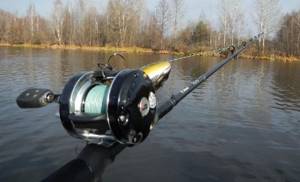
fishing line
The priority of equipment for trolling fishing is to install a non-stretch braided cord, which transmits the bite signal more clearly and quickly and takes up less volume in the spool, having high breaking load limits with smaller diameters. Multi-colored braided cords are comfortable for fishing; by the coloring of the sections, it is visually easy to determine the length of the unwinding of the tackle. Monofilament fishing lines, due to the high stretch coefficient and large diameters of the thread, are rarely used in trolling fishing and in very specific hunting conditions at short distances for carrying bait.
Choosing a boat - PVC or boat?
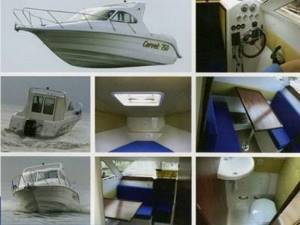
Nowadays boats are also equipped with outboard engines. Previously, it was also believed that a boat, unlike a motor boat, which is controlled from the stern, should have a console with a steering wheel. However, today many motorboats have such a console.
The modern criterion for determining the type of vessel is as follows : the crew (the maximum number of people for which the boat is designed) can independently launch a motorboat from land, but the weight of the boat does not allow this.
If it is a small flat river, an inflatable boat equipped with an electric motor will do. And if, for example, Lake Ladoga or the vast expanse of water of the Volga, there is nothing to do here without a reliable boat: PVC boats are not the best option for big waves .
Advantages of inflatable PVC boats:
- Compact, easy to transport when folded (no need for a trailer);
- There is no attachment to one body of water;
- Takes up little space when stored;
- Easy to maintain;
- Lasts a long time;
- Convenient on small rivers.
Disadvantages of inflatable PVC boats:
- An inflatable boat is not intended for fishing far from the coast;
- The boat must be assembled before use and disassembled after use.
Advantages of boats:
- Possibility of fishing far from the coast;
- Adaptability to large waves;
- Buy a large boat - prepare comfortable conditions for fishing;
- There is no need to assemble and disassemble the vessel;
- Opportunity to reach a professional level in fishing.
Disadvantages of boats:
- The question arises, where to store it?
- Requires a trailer for transportation;
- You need a powerful machine to pull a trailer.
Prices:
- Inflatable PVC boat “Pro Marine” 2.7 meters long - 8,290 rubles (2016);
- Corvette boats (Astron Marine) - from 300,772 to 3,000,000 rubles (2015);
- Professional fishing boat Larson - $23,286 (2015).
PVC trolling boat
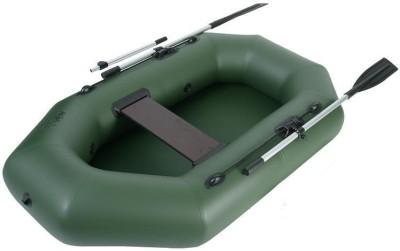
The larger the vessel, the better its controllability and ability to plane. If you need a boat for a body of water that does not have large waves, you can purchase a vessel with a low seaworthiness level.
Motors
To plane a boat with 30 kilograms of weight, 1 hp is needed . Let's say the boat is 4.2 meters long and weighs 100 kilograms.
It requires an engine with at least 12 hp. It’s good if there is a small power reserve - 3 hp. The maximum for an inflatable boat is an engine with 30 hp.
You don't need that much power for trolling. More than 15 hp not recommended : if the motor is more powerful, over time the structure of the punt will become deformed, because when the throttle is opened strongly, the bottom of the boat is subjected to strong impacts.
The optimal motor power for a hull boat (for example, Voronezh) is 25 hp. It is more difficult for it to go on plane than an inflatable one.
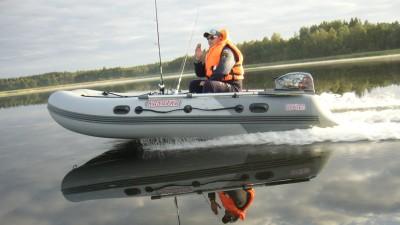
Power is not an indicator of all the characteristics of a trolling outboard motor. For example, Tohatsu-9.8, having the same power as Mercury-10, is very different from it in terms of speed and thrust, since the engines have different volumes. M-10 and M-15 are the same in volume, but their difference in power is 1.5 times. By the way, this difference has practically no effect on the price.
Motor with a power of 15 hp. costs approximately 1800 - 2200 US dollars. Price of an engine with a power of 25 hp. is in the range from 2400 to 2600 US dollars.
The leaders on the market now are motors made in Japan and the USA. Most of them have a warranty of 2 thousand hours. During this time, the car would have traveled 120 thousand kilometers, and for a boat such a resource means many years of use (rarely does anyone spend as much time at the tiller as behind the wheel of a car).
When choosing a specific model, pay attention to the following points:
- how much does the engine weigh?
- is there a service;
- Is the interface user-friendly?
- Does the dealer have spare parts in stock to repair the motor (if something fails and you need to order a part, the delivery time may be long, and free time for trolling fishing may be lost while waiting for the part).
Gasoline or electric?
If you use an electric motor on a fast-flowing river, the battery will quickly run out. An electric motor is a more suitable option for calm bodies of water.
Trolling on a two-stroke motor
It is believed that a 4-stroke motor is more suitable for trolling than a 2-stroke. The fact is that a 4-stroke engine is more environmentally friendly. In a 2-stroke engine, exhaust gases are forced out of the cylinder with a fresh mixture. It is impossible to completely displace the spent mixture without getting fresh mixture into the exhaust window.
However, there are also positive aspects in operating a 2-stroke engine (by the way, there are no less of them than negative ones): its power stroke is more frequent, therefore, with the same engine volume as a 4-stroke engine, it has more power. In addition, a 2-stroke motor is lighter and easier to maintain.
Requirements for the craft
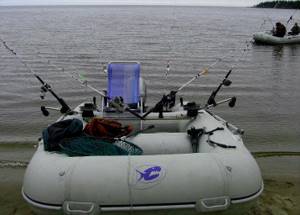
So, about trolling boats. What should they be:
- Boat. The most comfortable boat. For the most part, the boats are well seaworthy and allow you to load a large number of things. The only negative is the weight and dimensions.
- Inflatable motor boat. Its feature is mobility. Boats made of PVC material are compact. Models with a keel are quite stable on the water. Inflatable boats are relatively easy to maintain and more affordable. The running dimensions of the trolling vessel are 3.5-4 meters.
Motor: Today, most use foreign-made motors. Operation is simple, maintenance is not annoying. When purchasing a motor, you need to remember that the internal combustion engine has four strokes and is quieter than a two-stroke engine. Its fuel consumption is lower, but the engine itself is slightly more massive than a two-stroke and the price is higher.
On a note! If you don’t walk far on water, you can use power units with a capacity of 2-5 l/hp. If you plan to move 7-10 km from the anchorage, it is better to use a powerful engine that can bring the ship to planing in any weather.
On a PCV boat with two passengers, a motor with a power of 8-15 horses is often installed. This set is considered universal.
For trolling in small bodies of water, it is convenient to use a compact electric motor. The boat under it moves almost silently, which allows you to quietly approach promising places.
Recommended reading: Asp fish
Boat speed when trolling
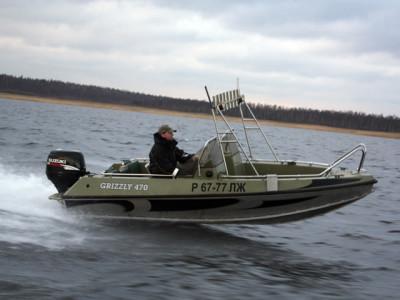
Often, a predator rushes at the bait when the speed of its retrieval increases. Some wobblers oscillate intensely at low boat speeds, while others begin to oscillate only when the speed increases.
Details in our articles: which wobblers are best to use for trolling fishing for catfish, pike perch and pike.
The boat's speed of 2.5 kilometers per hour allows you to catch fish in cold water: under this condition, the predator is sluggish and has no desire to chase fast-moving prey. The low speed also makes it possible to slowly move the bait over the river hole. The minimum speed of a boat depends on its resistance.
Technical wiring
There are no universal rules for trolling, since the fisherman acts depending on the fishing conditions and terrain. Good knowledge of the bottom of the reservoir, depth and underwater terrain, a high-quality echo sounder is all you need for effective trolling fishing.
- Attention! The use of expensive branded wobblers is not recommended, as there is a high probability of snagging.
In the absence of such information, we experiment. We move against the riverbed, deepening and raising the bait, which is determined by the terrain and goals. Trolling fishing on the river involves following these tips:
- Going deeper without a downrigger is accompanied by a decrease in movement speed.
- Perch and catfish love it when the bait lies on the bottom - trolling plus twitching with jerking to play the bait in the sand will give good results.
- If we catch pike, we periodically deepen and lower the bait with periodic pull-ups.
- Autumn is characterized by rains and other precipitation, so it is worth fishing in shallow water to look for trophy pike.
- Catfish do not walk in open space, especially when it is still hot, and even in autumn in Astrakhan it adheres to uneven terrain.
- A decrease in water temperature in October-November implies the use of fast bottom movements, since at this time the activity of the predator is maximum.
- To catch large predators, we use a zigzag stroke of the bait with periodic changes in speed.
Trolling fishing, a fishing technique that differs from our usual gear, is used in accordance with the effectiveness and intensity of bites. If there are no bites, we reduce the speed of movement, check the bait, and experiment with the fishing location. There may be no bite due to incorrectly selected bait.
